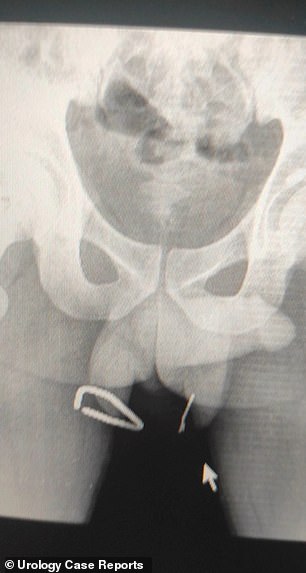Schizophrenic man, 23, hammers two NAILS into his scrotum ‘after being told to by imaginary person’
- The unidentified man from Tunisia went to hospital two days after the incident
- The 23-year-old had not been diagnosed with schizophrenia before his visit
Surgeons had to remove two nails from a schizophrenic man’s scrotum after he followed ‘an imaginary person’s command’.
Medics in Tunisia shared gory details of the incident in a medical journal and told how the unidentified 23-year-old’s testicles remained intact.
The man, who had not previously been diagnosed with a mental illness, showed up at the hospital two days after the incident complaining of pain in his testicle.
Psychiatrists diagnosed him with schizophrenia after concluding that he had committed the self-harm while suffering from ‘delusions’.
Doctors at La Rabta Hospital in Tunis said they believe this is the first case of a schizophrenic man inserting an object into his scrotum.

Surgeons in Tunisia shared gory details of the incident in a medical journal, telling how remarkably the unidentified 23-year-old’s testicles remained intact. The man only came to the hospital two days after the incident. Medics said the man, from Tunis, had not been diagnosed with the condition
“Schizophrenic patients commonly insert an object into the mouth or rectum, but insertion of a foreign body into the scrotum has not been reported to our knowledge,” she added.
The man told doctors at the hospital’s urology department that he had been suffering from pain in his scrotum for two days.
After being questioned by doctors, he admitted to inserting two nails into his scrotum. One measures 6 cm.
Examination revealed that one of the nails, which was thicker, pierced the scrotum in two places.
A pelvic x-ray revealed that a second, smaller nail fragment was lodged beneath the pubic symphysis, the joint sandwiched between the left and right pelvic bones.

The man attributed his action to “the command of an imaginary person.” He was later referred to the psychiatric ward, where he was diagnosed with schizophrenia
The man received a tetanus shot. It protects against the life-threatening condition, which is caused by bacteria getting into a wound.
Medics removed dead and infected tissue, thoroughly cleaned the wound and removed the nail.
Remarkably, he suffered no permanent damage to his testicles or epididymis – the tube that stores sperm.
He was discharged from hospital the next day and referred to the psychiatric ward, where doctors confirmed he was suffering from serious mental health problems.
They prescribed him antipsychotics – medications that reduce and control the symptoms of schizophrenia, including delusions and hallucinations.
Writing in the diary Urological case reportsmedics told them to retrieve items stuck in the scrotum are fortunately rare.
But they said, ‘The presentation is usually postponed due to feelings of shame and embarrassment.
‘When they occur, they can cause serious complications, such as loss of testicular tissue or urethral strictures.’
They added: ‘In our case, the patient suffered from schizophrenia, and under the guidance of an imaginary person, he inserted objects into his scrotum.’
Self-insertion of foreign objects into the scrotum or lower urinary tract can have various causes.
These may include psychological and psychiatric factors such as mental illness, borderline personality disorders, substance abuse and migration from other organs, they said.
The cause of schizophrenia is not understood and is believed to be a combination of genetics, abnormalities in brain chemistry, and/or possible viral infections and immune disorders.
Symptoms of schizophrenia usually begin between the ages of 16 and 30. They include hallucinations, confused thoughts and speech, and wanting to avoid people.
Figures show that around one per cent of the world’s population suffers from schizophrenia, including around 685,000 in Britain and two million in the US.
